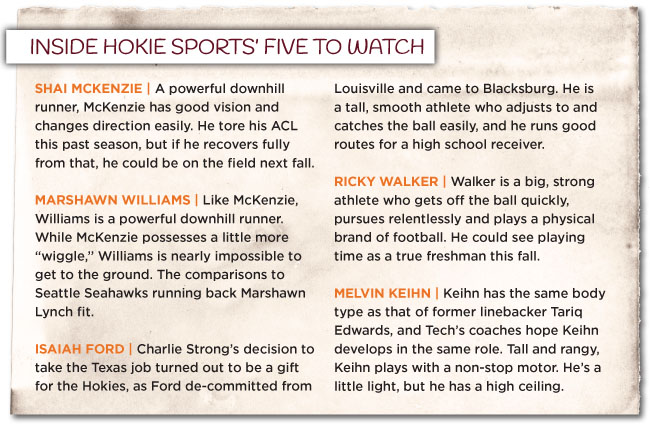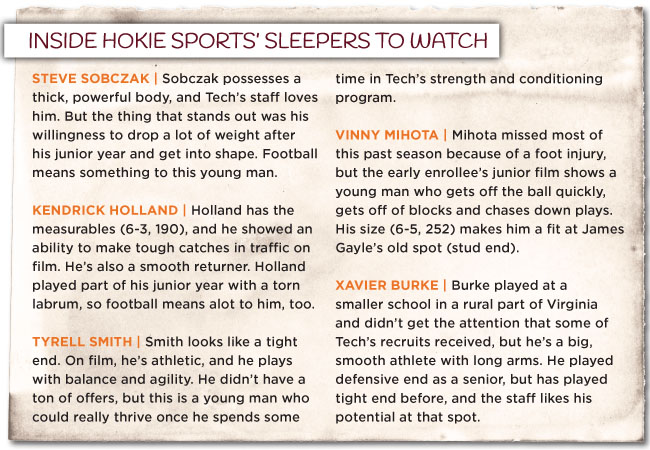Virginia Tech ranked 101st nationally in total offense and 99th in scoring offense this past season. The Hokies’ best weapon on offense, quarterback Logan Thomas, departed with numerous school records. Their best offensive lineman, Andrew Miller, also departed.
So it did not come as any surprise that Virginia Tech’s staff focused on finding playmakers on that side of the ball with the 2014 recruiting class.
Tech coach Frank Beamer and his coaches brought in a recruiting class that consisted of 28 total players, including two – defensive back Holland Fisher and tailback D.J. Reid – who signed with the Hokies last season but are spending the 2013-14 school year at Fork Union. Of those 28, 17 were projected to play on offense. Of those 17, four were listed as tailbacks and four as receivers.
“We ended up with a couple of great running backs, even though we feel good about the running backs in our program,” Tech coach Frank Beamer said. “But we felt like, with our receivers, we needed to upgrade there. I feel good now that we’ve got some with experience, a couple of more that we redshirted, and then the guys that we signed. I think we really helped ourselves with guys that can catch it and do something after the catch. That’s important. You’ve got to be able to catch it, but you’ve got to be able to do something with it.”
Most services that cover recruiting regularly think highly of the Hokies’ haul of skill players. One service, 247Sports, ranked Tech’s quarterback class No. 2 nationally, and it rated the Hokies’ running back group No. 4 nationally.
The quarterback contingent includes Andrew Ford, Chris Durkin and Travon McMillian, along with tailbacks Reid, Shai McKenzie, Marshawn Williams and Tabyus Taylor. McKenzie, a 5-foot-11, 215-pounder from Washington, Pa., and Williams, a 5-11, 224-pounder from Hampton, Va., earned four-star status (out of five) from Rivals and 247Sports, two services that cover recruiting.
McKenzie received his status despite missing much of his senior season with a torn ACL. Yet he rushed for 4,865 yards in his career – hence the ranking. Williams rushed for more than 4,000 yards in his career, including more than 2,000 this past season.
Ford, the Gatorade state player of the year in Pennsylvania, threw for 2,776 yards and 35 touchdowns as a senior. Durkin, an Ohio native, threw and rushed for more than 500 yards this past season. Both earned four-star status by 247Sports.

Their big numbers and potential for success in college led to most services ranking the Hokies’ class pretty high. Yet this class features balance and talent throughout. Tech’s staff signed four defensive linemen, and the class also includes four offensive linemen and five defensive backs.
Overall, 247Sports rated the class 20th nationally, while Rivals ranked the Hokies’ haul 25th nationally, with 12 prospects receiving four-star status. 247Sports ranked eight prospects with four stars.
“I think sometimes you’ve got to watch yourself,” Beamer said. “I think the Seattle Seahawks just proved that this weekend [in the Super Bowl]. They’re playing with a third-round quarterback. Most of their football team wasn’t highly recognized, but when they come together and give great effort and play their position smart and are dedicated to winning, you see that.”
Bringing in some playmakers
Offensive struggles the past two years aside, the coaches needed to replenish the offense anyway.
For starters, Tech only has two scholarship quarterbacks on the roster in Mark Leal and Brenden Motley, and Leal is a senior. The coaches moved the quarterbacks in last year’s class – Bucky Hodges and Carlis Parker – to different positions.
Enter McMillian, Ford and Durkin. McMillian may be the most versatile athlete in the class and may wind up at another position, but has been promised an opportunity to play quarterback. He threw for 1,472 yards and 17 touchdowns and rushed for 1,537 yards and 20 scores as a senior this past season at C.D. Hylton High.
They appear to be different types of quarterbacks, with McMillian being a dual-threat type and Ford being a left-handed pocket quarterback, while Durkin is nearly 40 pounds heavier than both and runs more. But they all possess one attribute attractive to the staff – intelligence.
“Intelligence is one of the least things talked about with quarterbacks,” said Tech tight ends coach Bryan Stinespring, who doubles as the program’s recruiting coordinator. “It’s always, ‘What’s his arm strength? How quick is his release? Is he mobile? What’s his size?’
“But we really talk about their ability to learn and the foundation they have. That’s going to be important because someone is going to have to come in and get into the quarterback mix. How quickly they can learn is really important to getting into that mix.”
At running back, the staff wanted to get bigger. Outside of Trey Edmunds, who is out this spring with a broken leg, the Hokies lacked a bigger running back, which played somewhat of a role in the Hokies’ red-zone and short yardage issues in 2013.
McKenzie, Williams and Taylor all weigh more than 215 pounds. McKenzie and Williams enrolled for the spring semester to get a head start on possibly getting on the field next fall.
“There were a lot of things that went into our red-zone issues,” Stinespring said. “It wasn’t just one person or one position. But we did want some guys with some size [at tailback], and these guys are already in the 215-pound range, with the opportunity to get bigger. Getting a couple of guys with size was a part of our thought process.”
Then there is the situation at receiver. Tech’s leading receiver last year was a former walk-on (Willie Byrn). Outside of Demitri Knowles, the Hokies lacked vertical speed to stretch a defense. A year ago, Tech’s offense recorded just 15 pass plays of 30 yards or more.
In addition, the Hokies lacked depth at those spots. Tech brought in just two true receivers the past two years – none in last year’s class.
So Tech’s staff went after playmakers at the receiver spots – in a big way.
The coaching staff signed four receivers, a group that included Isaiah Ford from Jacksonville, Fla.; Cam Phillips from Laurel, Md.; Kendrick Holland from Winter Haven; Fla.; and Jaylen Bradshaw from Chesapeake, Va.
Ford reeled in 37 catches for 719 yards and 12 touchdowns, and he accounted for 1,067 all-purpose yards and 17 touchdowns this past season. Holland caught 32 passes for 770 yards and six touchdowns, while Phillips caught 68 passes for 1,233 yards and 15 touchdowns. Bradshaw hauled in 65 passes for 1,102 yards and 18 touchdowns.
“In the last three years, we’ve lost Danny Coale, Jarrett Boykin, Marcus Davis, Dyrell Roberts and D.J. Coles,” Stinespring said. “That’s a significant group of individuals. Then, all of a sudden, Demitri Knowles is a junior, and Willie Byrn is a senior. We wanted to reinforce that group, and we thought it was a strong wide receiving class, which suited our needs.”
Shoring up the offensive line
Along the offensive line, Tech’s staff kept four of the five offensive line prospects who had committed while Jeff Grimes was the offensive line coach (Grimes left to take the same position at LSU). Only Columbus, Ohio, native Brady Taylor switched commitments after he got an offer from his hometown Ohio State Buckeyes.
Tech’s offensive line signees include Eric Gallo from Richboro, Pa.; Billy Ray Mitchell from Westwood, N.J.; Tyrell Smith from North Brunswick, N.J.; and Colt Pettit from Deshler, Ohio. None of them weigh more than 285 pounds, but the staff liked that about this group
“Each of them has a great upside, and what we take great pride in is our development of players,” Stinespring said. “And this group, because of its upside, is going to benefit from Mike Gentry [Tech’s associate AD for athletic performance] and his staff and our coaching. This group fits into our mold of what we like to think is one of our strengths – their upside and our ability to develop. I think it works well together.”
The offensive line has been a troublesome area for the staff in recent years, though the coaches felt the 2013 line played pretty well, and the staff continues to put resources into the offensive line. A year ago, they inked four offensive linemen as well (Jonathan McLaughlin, Kyle Chung, Braxton Pfaff and Parker Osterloh).
This year’s crop means that 17 offensive linemen on the projected 2014 roster are on scholarship. That is a lot, but the Hokies lose six linemen after next season (Caleb Farris, Mark Shuman, Matt Arkema, Laurence Gibson, Brent Benedict and David Wang). Plus, it takes a while to develop linemen.
The last signee on offense, but not the least, was tight end Xavier Burke, a 6-3, 245-pounder from Lawrenceville, Va. Stinespring recruited Burke himself and loves that he’s a smooth athlete with the ability to play in space.
“He’s an easy runner, and I know he’s going to get faster,” Stinespring said. “He weighs 245, and he looks like he’s 220. It wouldn’t surprise me if he got to 275.”
Adding to the defensive front
A year ago, Tech’s staff signed just one defensive lineman – Wyatt Teller. Not long after fall practice started, the staff moved Teller to the offensive line. So in essence, the staff lost four defensive linemen this season – Teller, James Gayle, Derrick Hopkins and J.R. Collins.
That meant the staff needed to find replacements in this recruiting class, and the defensive line signees in this class include Ricky Walker from Hampton, Va.; Vinny Mihota from Fredericksburg, Va.; Steve Sobczak from Milford, Va.; and Kevin Bronson from Boynton Beach, Fla.
Walker and Sobczak should anchor Tech’s defensive tackle spots for years to come. Walker recorded 73 tackles and 11 sacks this past season, while Sobczak had 21 tackles for a loss. Expect one or both to play next season, as the Hokies possess little depth at the tackle spot.
Mihota enrolled at Tech for the spring semester. He missed most of his senior season with a foot injury, but the coaches love his potential. Bronson recorded 58 tackles and 9 sacks this past season.
Tech’s defensive line got much bigger with this group. None weigh less than 250 pounds.
“These guys share the ability level and skill set, but they also share the intangibles that our defensive staff is looking for,” Stinespring said. “These guys have a high-motor level and are looking to get better.”
Elsewhere on defense, Melvin Keihn projects as a backer in the Tariq Edwards mold. His speed enables him to chase plays all over the field, and he recorded 85 tackles and 9 sacks as a senior.
Tech’s staff also added to the defensive backfield despite going heavy at those four spots the past few years. A year ago, the staff signed six prospects projected to play in the secondary – Fisher, Kendall Fuller, Brandon Facyson, Chuck Clark, Anthony Shegog and Cequan Jefferson. After a season at Fork Union, Jefferson decided to sign with Temple, but the other five remain, including Fisher, who also went to Fork Union, but re-signed with the Hokies.
This class features defensive backs Terrell Edmunds, Greg Stroman, Shawn Payne and C.J. Reavis. The first three probably got more notoriety for their exploits on offense in high school (Edmunds as a running back, Stroman as a quarterback, Payne as a receiver), but project as defensive backs because of their athleticism. Reavis, from Chester, Va., recorded 87 tackles and 4 interceptions as a senior at Thomas Dale High School this past season.
McMillian could factor in as a defensive back as well, though the coaching staff wants to give him a look at quarterback and maybe receiver.
“You always have two or three guys in your class with diversity,” Stinespring said. “They can play any number of positions. I think he’s [McMillian] one of them. He’ll get a look at quarterback because he’s played that position, and we want to evaluate him there. But he’s versatile. Stroman and Terrell Edmunds have shown they can play a couple of different positions. We’ll zone in on one [position] once they get here and go from there.”
Wrapping it up
Tech’s staff also signed a kicker in Michael Santamaria from Athens, Ga., the lone specialist in the class. Given the Hokies’ kicking issues a year ago – they used four different kickers – they needed a kicker. Beamer said he expected two walk-ons to join the program and also contend for the job.
There was no resting for Tech’s staff following signing day. The staff held a “junior day” the Saturday after signing day –the coaches’ earliest junior day yet – and planned at least two more junior days, including one that coincides with Tech’s spring game.
“We’ve done a great job in our evaluation and developing, but this [recruiting] game has sped up,” Stinespring said. “We wanted to make a few adjustments to meet the challenges in recruiting and advance ourselves, too.
“We’re diligently at work on our 2015 class, as you can tell by some commitments already, and we have a board set up for our 2016 class. We have a present plan, an immediate future plan, and then a two-year plan in recruiting. We’ve even got the beginning foundation of the 2017 plan.”
For now, he, Beamer and the rest of the staff like the immediate future. The 2014 recruiting class will go a long way toward determining next year’s success – and beyond.
“This wasn’t going to be a class that was defined by an individual,” Stinespring said. “We’re not going to get away from finding the best players that you can recruit, but you’ve got to meet your needs and stay on target. There is a fine balancing act. You’ve got to make sure at the end that you feel good about strengthening the areas that you needed to strengthen. You want to strengthen every area, but certain areas may require more attention, and I think we did a good job at that.”





